Attached files
| file | filename |
|---|---|
| 8-K - 8-K - Education Realty Trust, Inc. | a8-kbylawamendmentbarrowre.htm |
| EX-3.1 - EXHIBIT 3.1 - Education Realty Trust, Inc. | amendmentno2totheamendedan.htm |
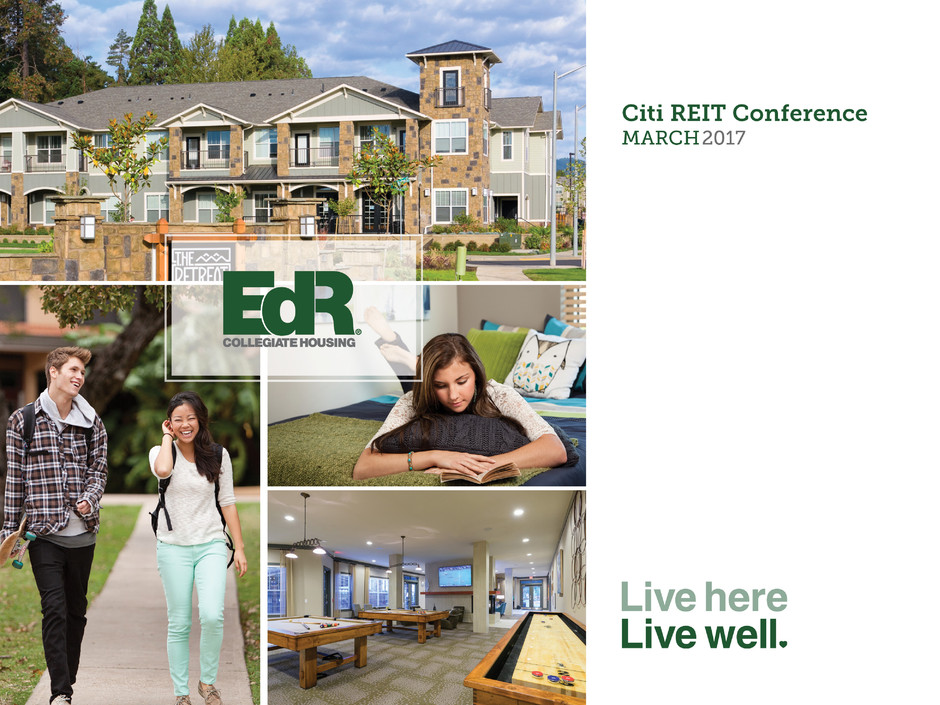
1
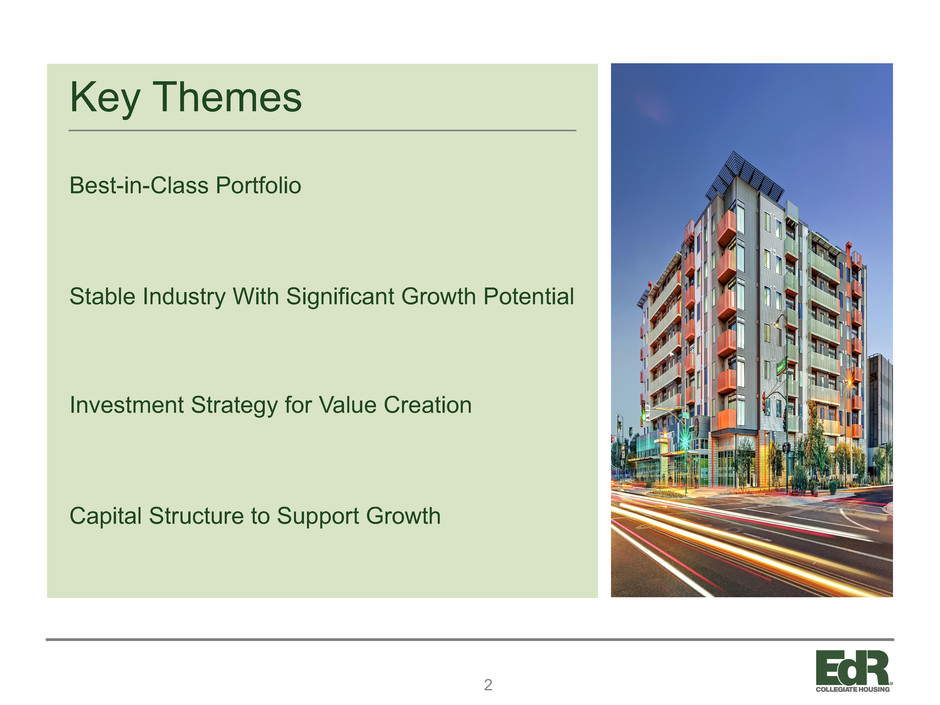
2
Key Themes
Stable Industry With Significant Growth Potential
Best-in-Class Portfolio
Investment Strategy for Value Creation
Capital Structure to Support Growth
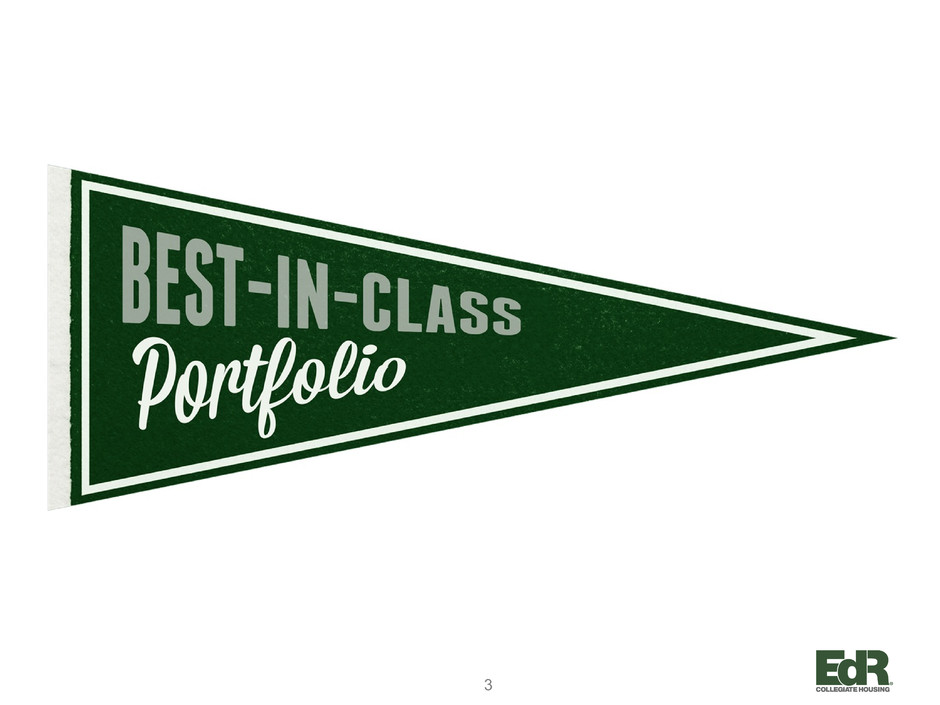
3
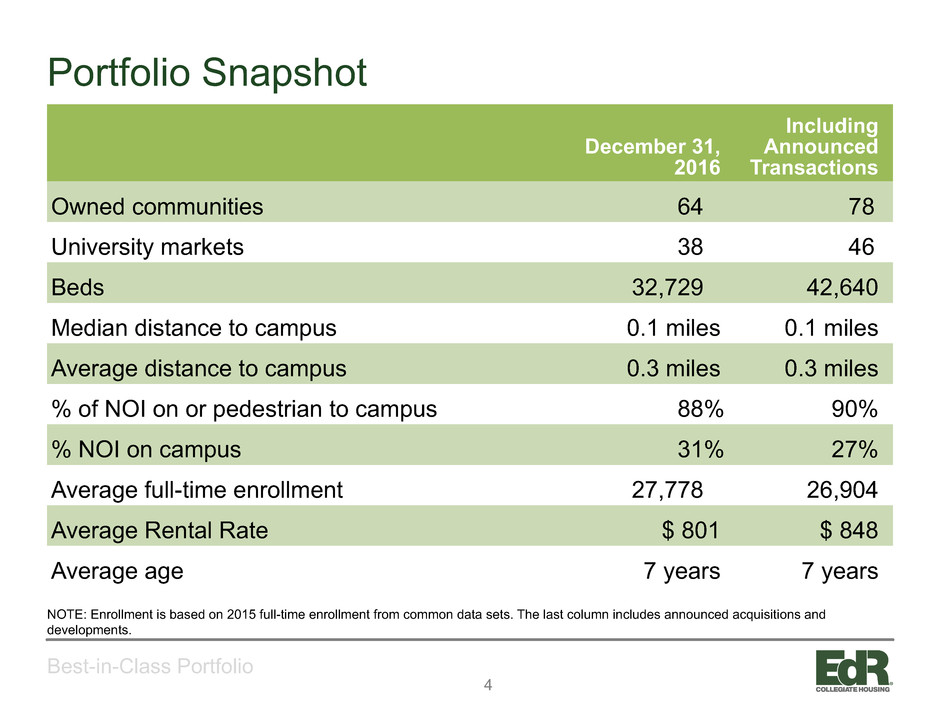
4
Portfolio Snapshot
Best-in-Class Portfolio
December 31,
2016
Including
Announced
Transactions
Owned communities 64 78
University markets 38 46
Beds 32,729 42,640
Median distance to campus 0.1 miles 0.1 miles
Average distance to campus 0.3 miles 0.3 miles
% of NOI on or pedestrian to campus 88% 90%
% NOI on campus 31% 27%
Average full-time enrollment 27,778 26,904
Average Rental Rate $ 801 $ 848
Average age 7 years 7 years
NOTE: Enrollment is based on 2015 full-time enrollment from common data sets. The last column includes announced acquisitions and
developments.
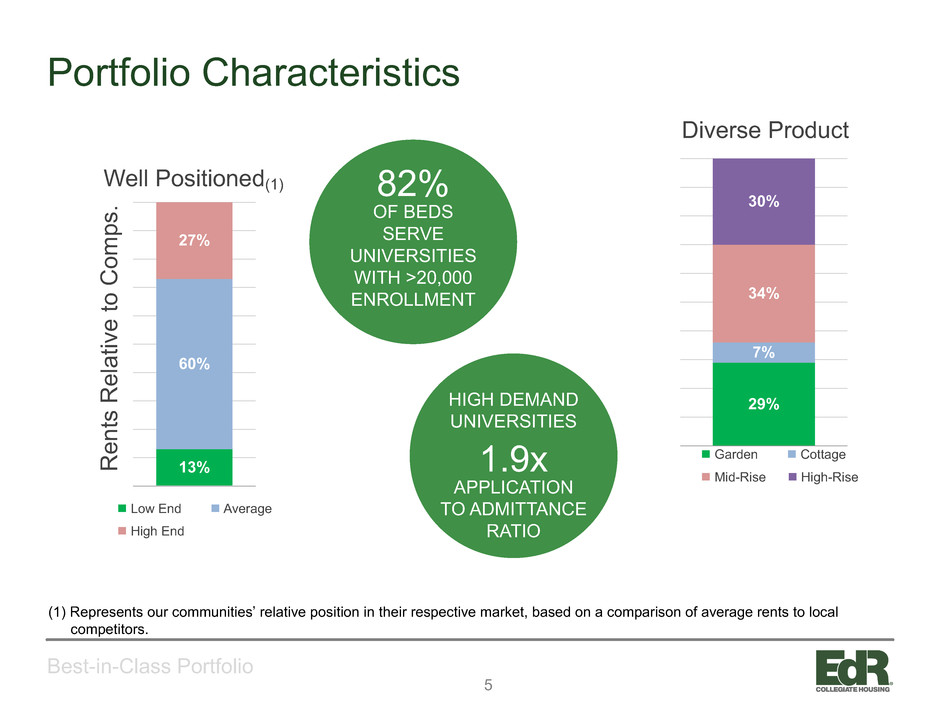
5
Portfolio Characteristics
Best-in-Class Portfolio
82%
OF BEDS
SERVE
UNIVERSITIES
WITH >20,000
ENROLLMENT
HIGH DEMAND
UNIVERSITIES
1.9x
APPLICATION
TO ADMITTANCE
RATIO
(1) Represents our communities’ relative position in their respective market, based on a comparison of average rents to local
competitors.
R
en
ts
R
el
at
iv
e
to
C
om
ps
.
13%
60%
27%
29%
7%
34%
30%
n Low End n Average
n High End
n Garden n Cottage
n Mid-Rise n High-Rise
Diverse Product
Well Positioned(1)
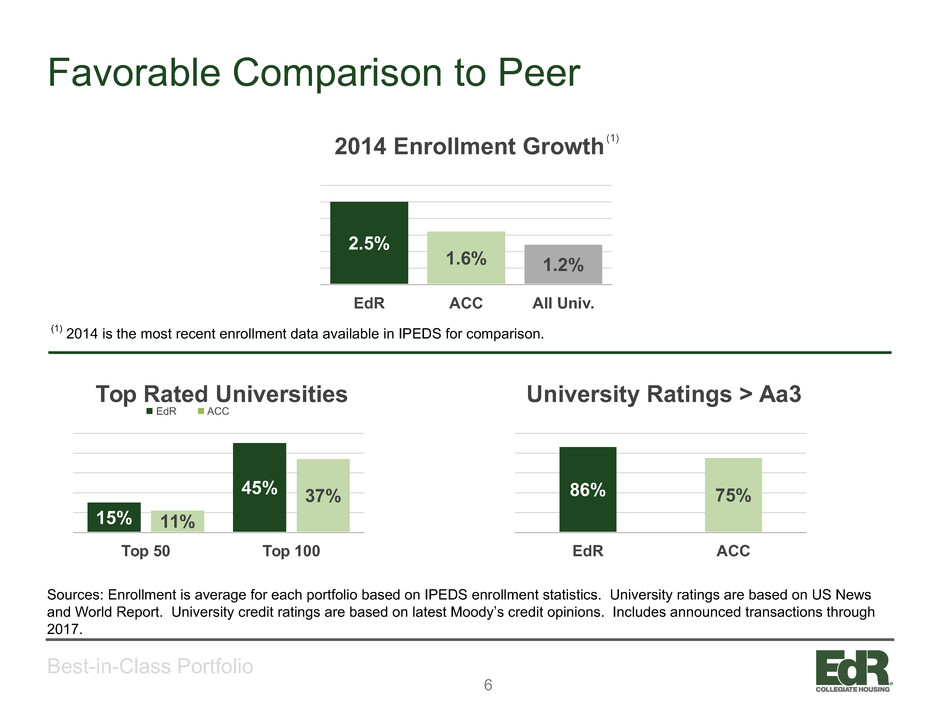
6
Favorable Comparison to Peer
Best-in-Class Portfolio
Sources: Enrollment is average for each portfolio based on IPEDS enrollment statistics. University ratings are based on US News
and World Report. University credit ratings are based on latest Moody’s credit opinions. Includes announced transactions through
2017.
2014 Enrollment Growth
EdR ACC All Univ.
2.5%
1.6% 1.2%
Top Rated Universities
Top 50 Top 100
15%
45%
11%
37%
University Ratings > Aa3
EdR ACC
86% 75%
n EdR n ACC
(1)
(1) 2014 is the most recent enrollment data available in IPEDS for comparison.
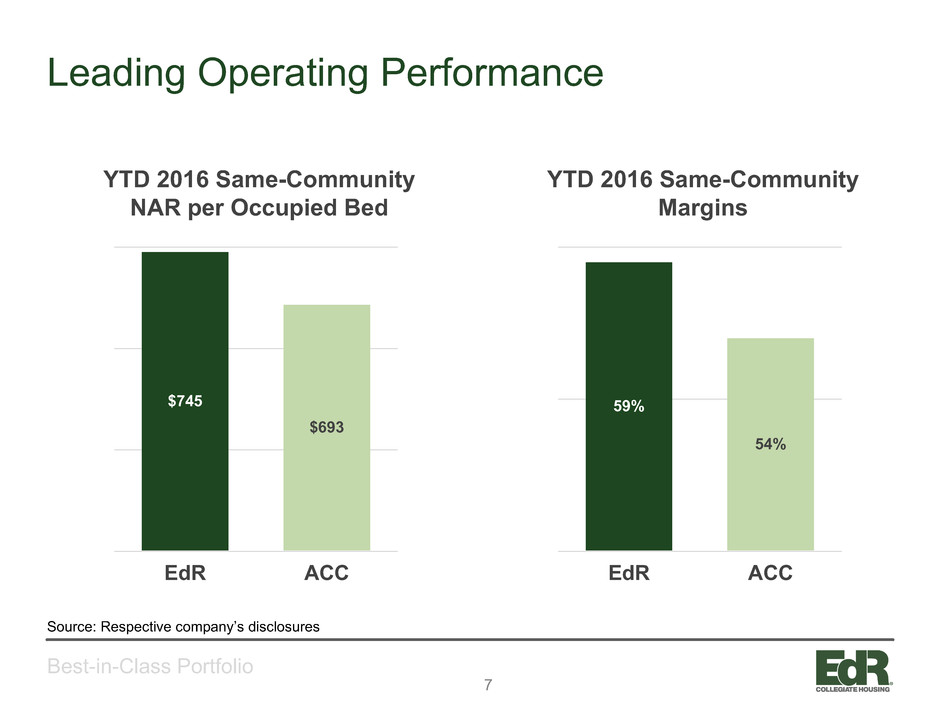
7
Leading Operating Performance
Best-in-Class Portfolio
Source: Respective company’s disclosures
YTD 2016 Same-Community
NAR per Occupied Bed
EdR ACC
$745
$693
YTD 2016 Same-Community
Margins
EdR ACC
59%
54%
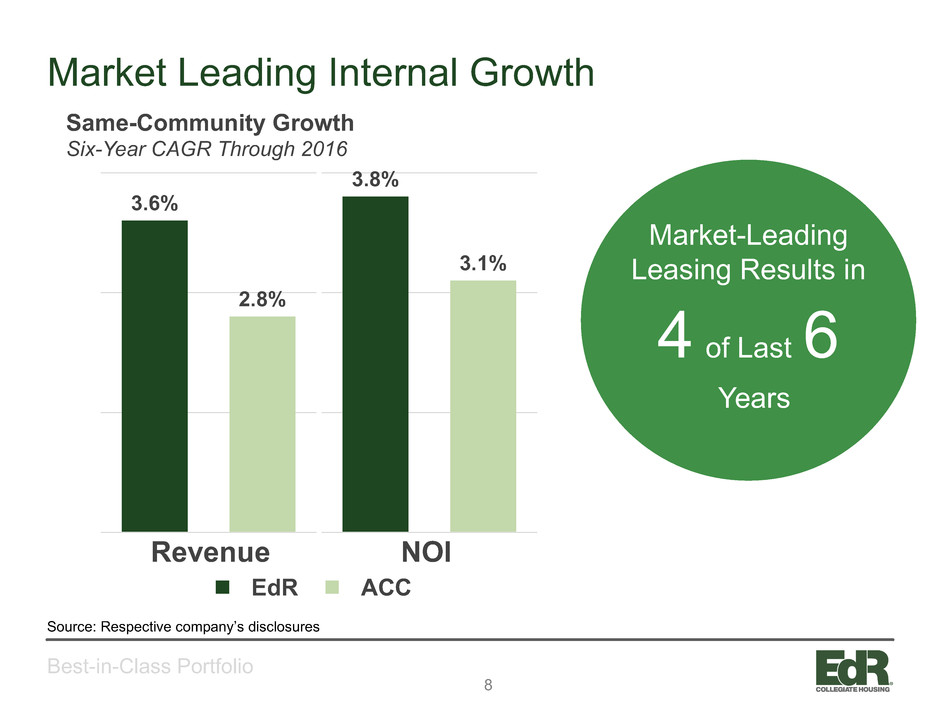
8
Market Leading Internal Growth
Best-in-Class Portfolio
Source: Respective company’s disclosures
3.6%
2.8%
3.8%
3.1%
Revenue NOI
Market-Leading
Leasing Results in
4 of Last 6
Years
Same-Community Growth
Six-Year CAGR Through 2016
EdR ACC

9
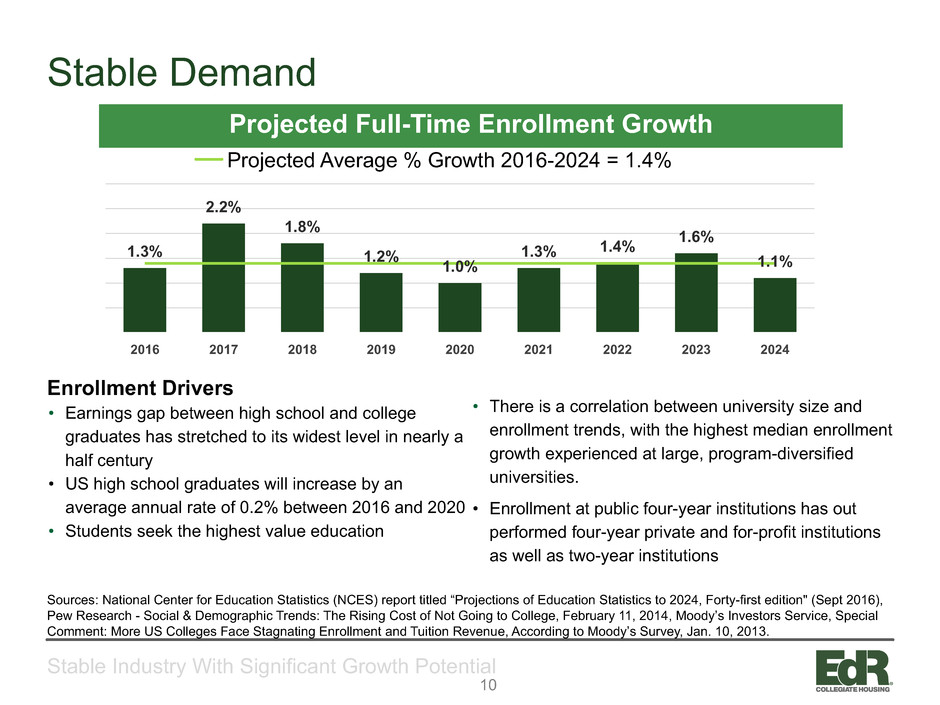
10
Stable Demand
Stable Industry With Significant Growth Potential
Projected Full-Time Enrollment Growth
Projected Average % Growth 2016-2024 = 1.4%
Sources: National Center for Education Statistics (NCES) report titled “Projections of Education Statistics to 2024, Forty-first edition" (Sept 2016),
Pew Research - Social & Demographic Trends: The Rising Cost of Not Going to College, February 11, 2014, Moody’s Investors Service, Special
Comment: More US Colleges Face Stagnating Enrollment and Tuition Revenue, According to Moody’s Survey, Jan. 10, 2013.
Enrollment Drivers
• Earnings gap between high school and college
graduates has stretched to its widest level in nearly a
half century
• US high school graduates will increase by an
average annual rate of 0.2% between 2016 and 2020
• Students seek the highest value education
• There is a correlation between university size and
enrollment trends, with the highest median enrollment
growth experienced at large, program-diversified
universities.
• Enrollment at public four-year institutions has out
performed four-year private and for-profit institutions
as well as two-year institutions
2016 2017 2018 2019 2020 2021 2022 2023 2024
1.3%
2.2%
1.8%
1.2% 1.0%
1.3% 1.4%
1.6%
1.1%
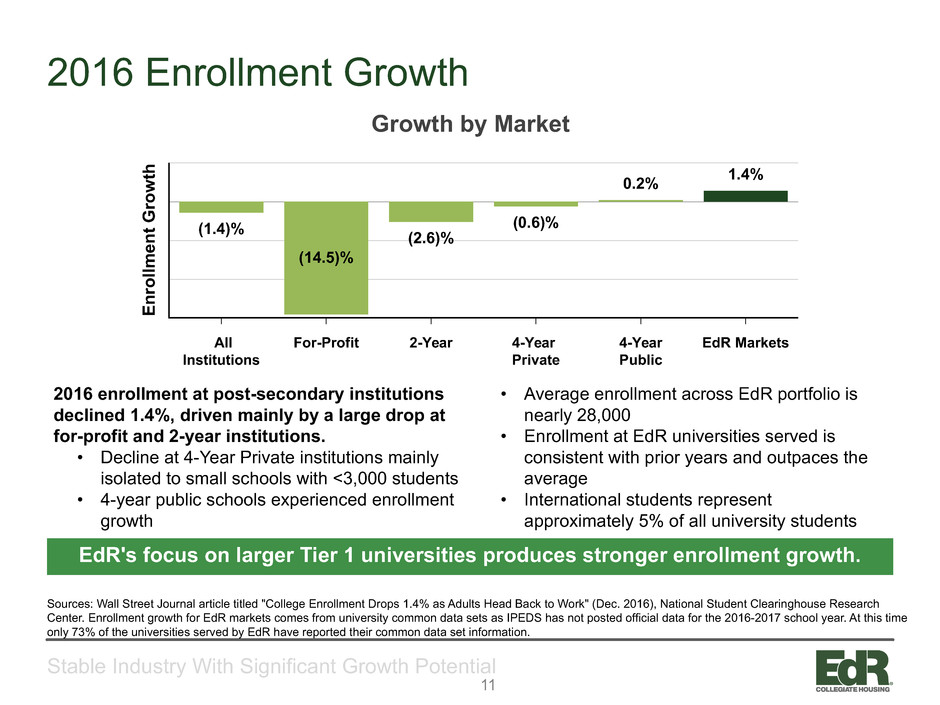
11
2016 Enrollment Growth
Stable Industry With Significant Growth Potential
2016 enrollment at post-secondary institutions
declined 1.4%, driven mainly by a large drop at
for-profit and 2-year institutions.
• Decline at 4-Year Private institutions mainly
isolated to small schools with <3,000 students
• 4-year public schools experienced enrollment
growth
Sources: Wall Street Journal article titled "College Enrollment Drops 1.4% as Adults Head Back to Work" (Dec. 2016), National Student Clearinghouse Research
Center. Enrollment growth for EdR markets comes from university common data sets as IPEDS has not posted official data for the 2016-2017 school year. At this time
only 73% of the universities served by EdR have reported their common data set information.
• Average enrollment across EdR portfolio is
nearly 28,000
• Enrollment at EdR universities served is
consistent with prior years and outpaces the
average
• International students represent
approximately 5% of all university students
Growth by Market
En
ro
llm
en
tG
ro
w
th
All
Institutions
For-Profit 2-Year 4-Year
Private
4-Year
Public
EdR Markets
(1.4)%
(14.5)%
(2.6)%
(0.6)%
0.2% 1.4%
EdR's focus on larger Tier 1 universities produces stronger enrollment growth.
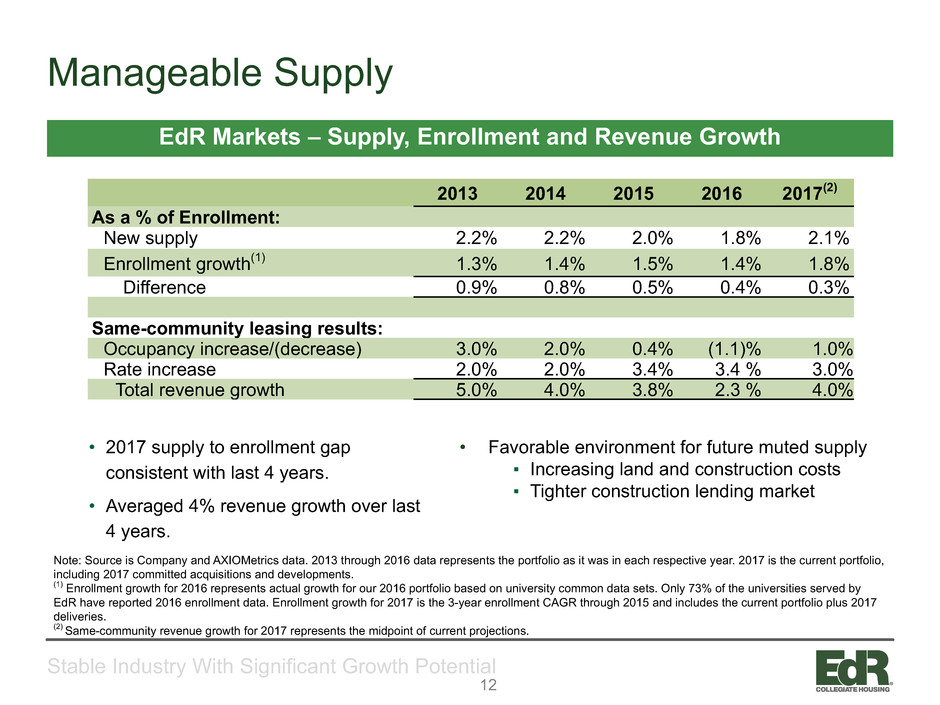
12
Manageable Supply
Stable Industry With Significant Growth Potential
EdR Markets – Supply, Enrollment and Revenue Growth
Note: Source is Company and AXIOMetrics data. 2013 through 2016 data represents the portfolio as it was in each respective year. 2017 is the current portfolio,
including 2017 committed acquisitions and developments.
(1) Enrollment growth for 2016 represents actual growth for our 2016 portfolio based on university common data sets. Only 73% of the universities served by
EdR have reported 2016 enrollment data. Enrollment growth for 2017 is the 3-year enrollment CAGR through 2015 and includes the current portfolio plus 2017
deliveries.
(2) Same-community revenue growth for 2017 represents the midpoint of current projections.
(14%) (23%) (22%)
2013 2014 2015 2016 2017(2)
As a % of Enrollment:
New supply 2.2% 2.2% 2.0% 1.8% 2.1%
Enrollment growth(1) 1.3% 1.4% 1.5% 1.4% 1.8%
Difference 0.9% 0.8% 0.5% 0.4% 0.3%
Same-community leasing results:
Occupancy increase/(decrease) 3.0% 2.0% 0.4% (1.1)% 1.0%
Rate increase 2.0% 2.0% 3.4% 3.4 % 3.0%
Total revenue growth 5.0% 4.0% 3.8% 2.3 % 4.0%
• 2017 supply to enrollment gap
consistent with last 4 years.
• Averaged 4% revenue growth over last
4 years.
• Favorable environment for future muted supply
▪ Increasing land and construction costs
▪ Tighter construction lending market
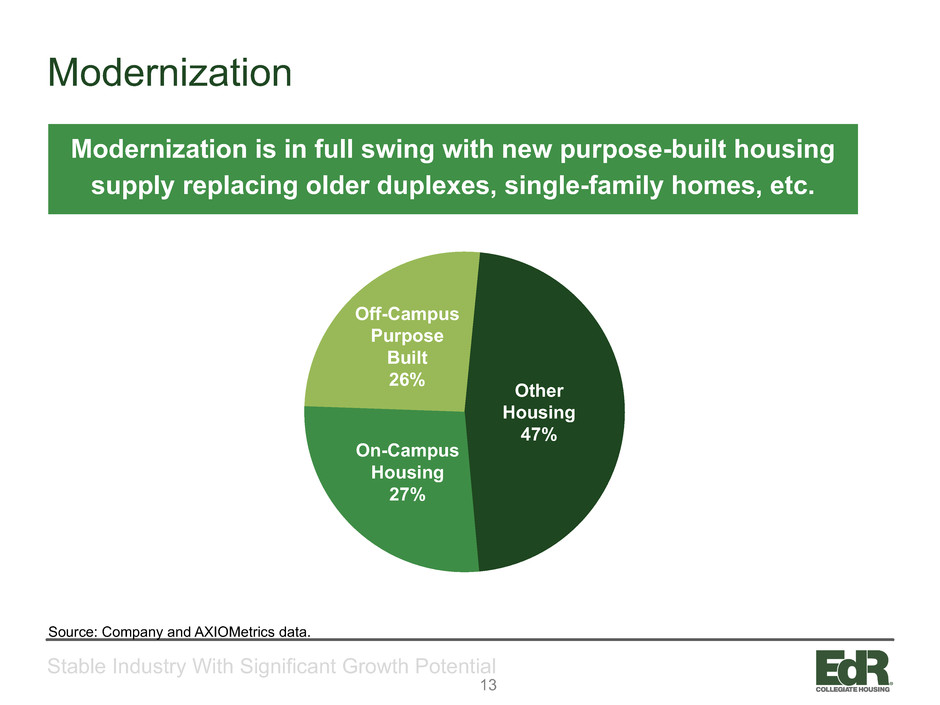
13
Modernization
Stable Industry With Significant Growth Potential
Modernization is in full swing with new purpose-built housing
supply replacing older duplexes, single-family homes, etc.
Source: Company and AXIOMetrics data.
Off-Campus
Purpose
Built
26% Other
Housing
47%
On-Campus
Housing
27%
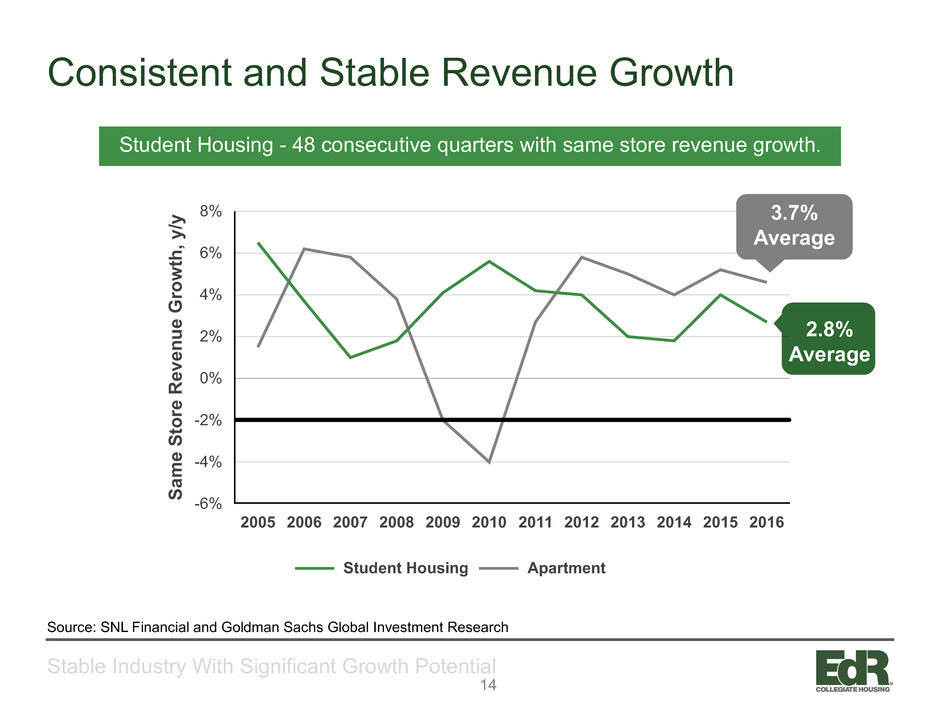
14
Consistent and Stable Revenue Growth
Stable Industry With Significant Growth Potential
Student Housing - 48 consecutive quarters with same store revenue growth.
Source: SNL Financial and Goldman Sachs Global Investment Research
Student Housing Apartment
8%
6%
4%
2%
0%
-2%
-4%
-6%S
am
e
St
or
e
R
ev
en
ue
G
ro
w
th
,y
/y
2005 2006 2007 2008 2009 2010 2011 2012 2013 2014 2015 2016
2.8%
Average
3.7%
Average
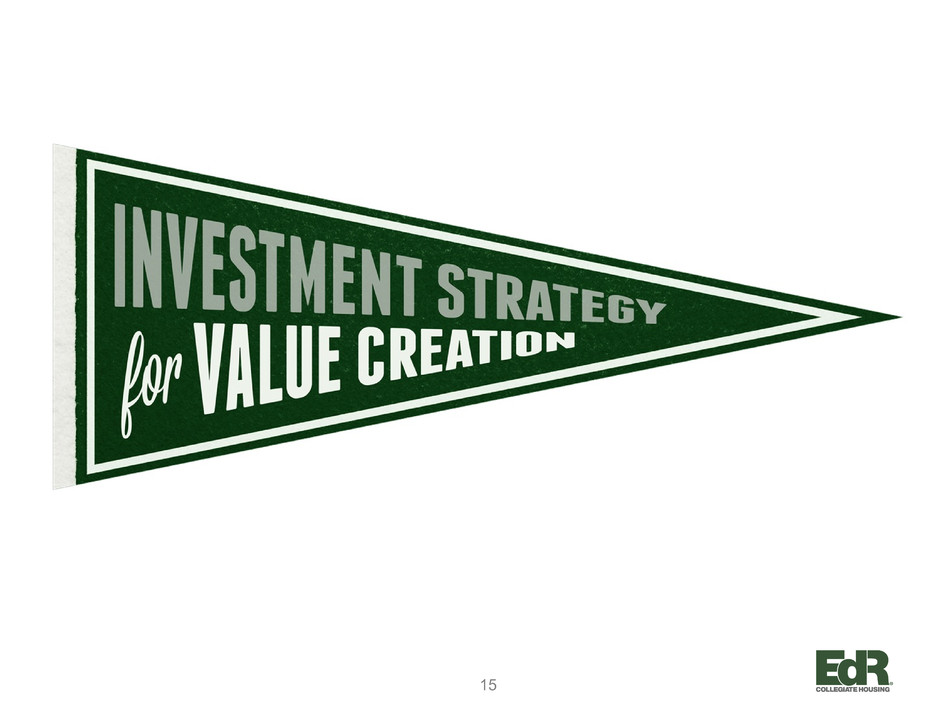
15

16
2017 acquisitions(1) $145mm
2017 – 2019 development deliveries $985mm
Median distance to campus 0.1 miles
Average distance to campus 0.3 miles
Average full-time enrollment 25,412
Average development yields 6.5% - 7.0%
46%
GROWTH IN
COLLEGIATE
HOUSING
ASSETS FROM 2016
31%
OF
DEVELOPMENTS
ARE ON-CAMPUS
Embedded External Growth
Investment Strategy for Value Creation
(1) Includes the acquisition of the Retreat at Corvallis which closed in January 2017, 319 Bragg
which closed in February 2017 and the second closing of Urbane which will occur in September
2017.
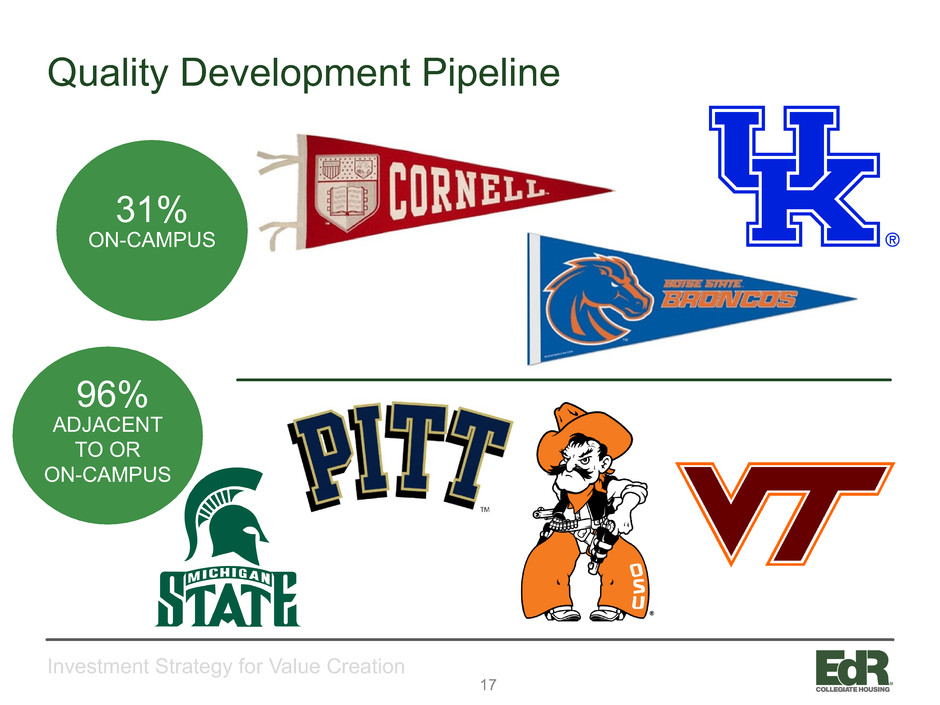
17
Quality Development Pipeline
Investment Strategy for Value Creation
31%
ON-CAMPUS
96%
ADJACENT
TO OR
ON-CAMPUS
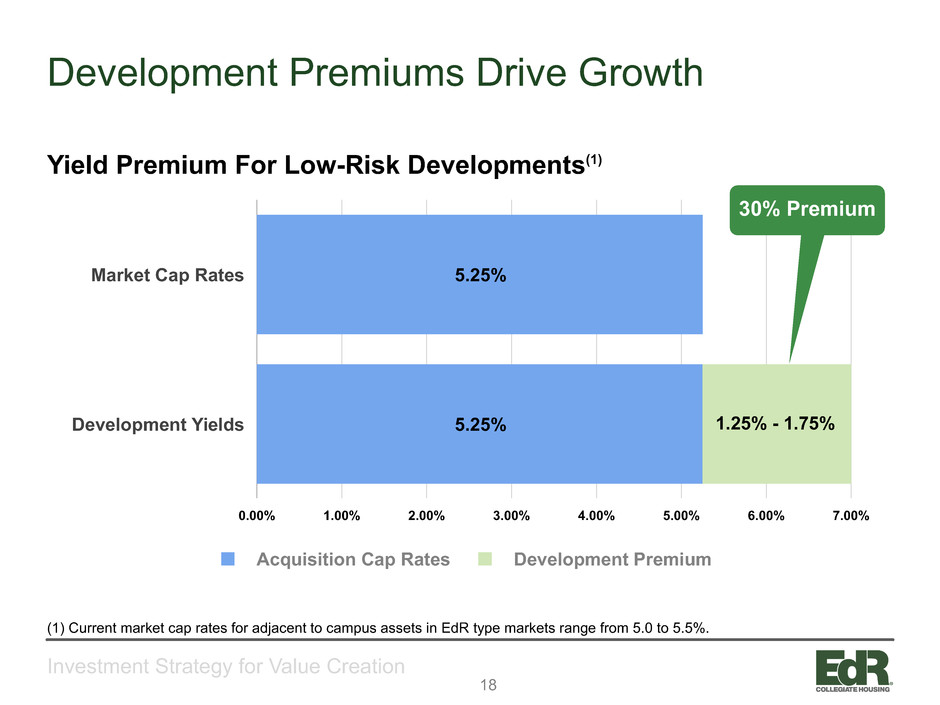
18
Development Premiums Drive Growth
Investment Strategy for Value Creation
Yield Premium For Low-Risk Developments(1)
(1) Current market cap rates for adjacent to campus assets in EdR type markets range from 5.0 to 5.5%.
Acquisition Cap Rates Development Premium
0.00% 1.00% 2.00% 3.00% 4.00% 5.00% 6.00% 7.00%
Market Cap Rates
Development Yields
5.25%
5.25%
30% Premium
1.25% - 1.75%
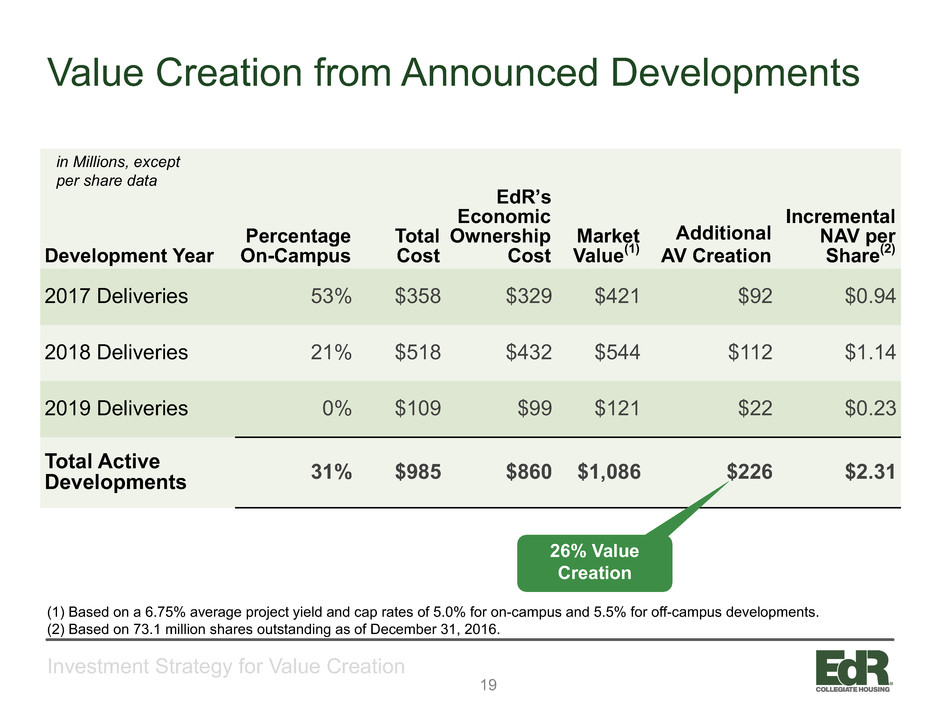
19
Development Year
Percentage
On-Campus
Total
Cost
EdR’s
Economic
Ownership
Cost
Market
Value(1)
Additional
AV Creation
Incremental
NAV per
Share(2)
2017 Deliveries 53% $358 $329 $421 $92 $0.94
2018 Deliveries 21% $518 $432 $544 $112 $1.14
2019 Deliveries 0% $109 $99 $121 $22 $0.23
Total Active
Developments 31% $985 $860 $1,086 $226 $2.31
Value Creation from Announced Developments
Investment Strategy for Value Creation
(1) Based on a 6.75% average project yield and cap rates of 5.0% for on-campus and 5.5% for off-campus developments.
(2) Based on 73.1 million shares outstanding as of December 31, 2016.
in Millions, except
per share data
26% Value
Creation
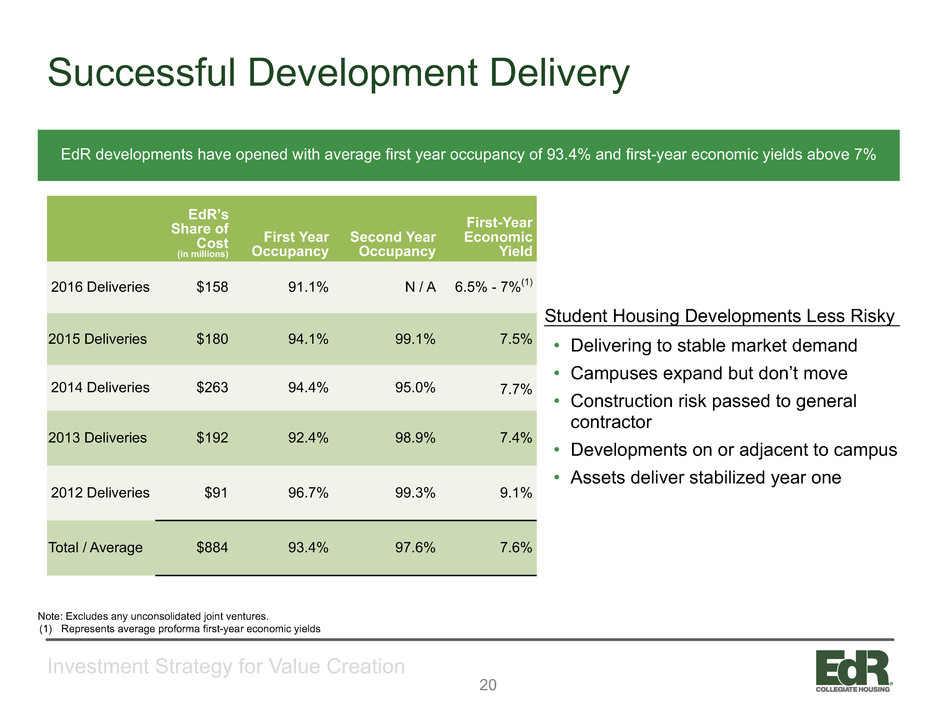
20
EdR’s
Share of
Cost
(in millions)
First Year
Occupancy
Second Year
Occupancy
First-Year
Economic
Yield
2016 Deliveries $158 91.1% N / A 6.5% - 7%(1)
2015 Deliveries $180 94.1% 99.1% 7.5%
2014 Deliveries $263 94.4% 95.0% 7.7%
2013 Deliveries $192 92.4% 98.9% 7.4%
2012 Deliveries $91 96.7% 99.3% 9.1%
Total / Average $884 93.4% 97.6% 7.6%
Note: Excludes any unconsolidated joint ventures.
(1) Represents average proforma first-year economic yields
EdR developments have opened with average first year occupancy of 93.4% and first-year economic yields above 7%
Student Housing Developments Less Risky
• Delivering to stable market demand
• Campuses expand but don’t move
• Construction risk passed to general
contractor
• Developments on or adjacent to campus
• Assets deliver stabilized year one
Successful Development Delivery
Investment Strategy for Value Creation
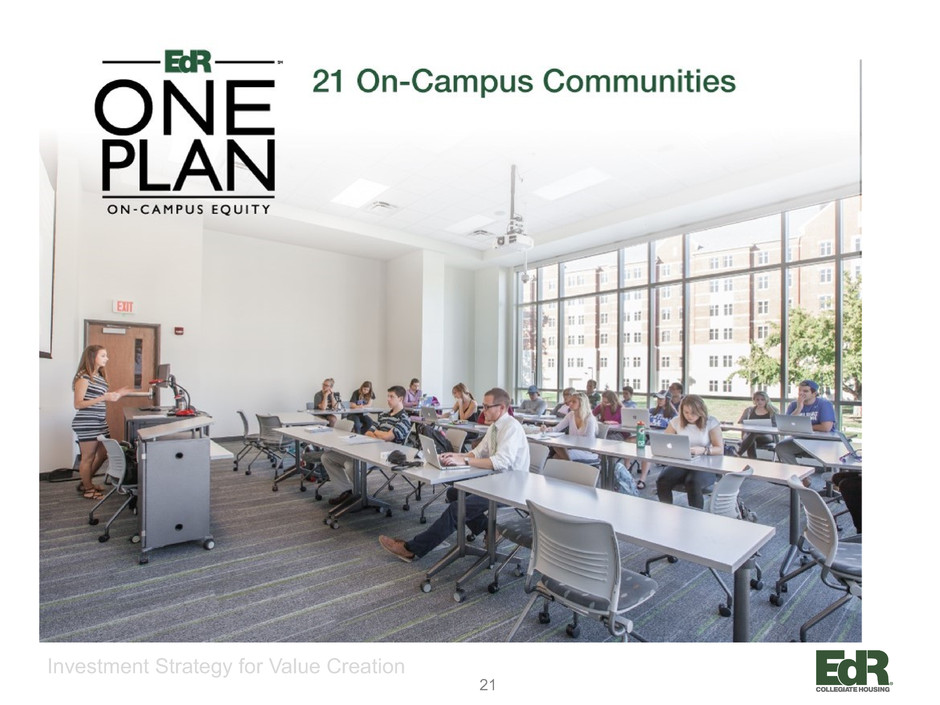
21
Investment Strategy for Value Creation

22
On-Campus Market Context
Investment Strategy for Value Creation
University Market Trends
▪ Reduction in state funding
▪ Demographic shifts
▪ Significant deferred maintenance
▪ Increasing competitiveness for
students
▪ On-campus students perform better
Main Reasons Universities Pursue P3s
▪ Funding shortfalls
▪ Risk transfer
▪ Operational efficiencies
▪ Project efficiencies
▪ Debt control
Enrollment
Growth
7.2% State
Appropriations
(14.6%)
Source: Center on Budget & Policy Priorities, Aon Infrastructure Solutions and P3C Conference Survey Report.
(‘07 to ’14)
(‘07 to ’14)

23
Public REITs Dominate Equity P3s
Investment Strategy for Value Creation
NOTE: Combined public company results from company financial supplements.
Significant Competitive Advantages
▪ Proven on-campus development and
management expertise
▪ Well-capitalized balance sheet
▪ Size and depth of resources
▪ Public company transparency
▪ Long-term owner of assets
2009 2016
$0.3 Billion
$1.6 Billion
Delivered On-Campus
Equity Developments

24
ONE Plan History
Investment Strategy for Value Creation
• Best risk-adjusted return
• Currently 31% NOI from on-campus
assets
• Awarded 2 most recent equity
developments
• Robust pipeline of opportunities
(1) Based on average economic yield of 6.75% and cap rate of 5.0%
(2) Current and announced ONE Plan investments
ONE Plan Investments
2010 2011 2012 2013 2014 2015 2016 2017 2018
$26 $81 $111
$204
$342
$443
$527
$718
$829
54%
CAGR
Market Value(1)
$1,120
(2)
Year-End Cumulative Cost
in Millions

25
On-Campus Market Continues to Grow
Investment Strategy for Value Creation
▪ 30+ Active pursuits
▪ New housing growth: South / West
▪ Replacement housing: Midwest / Northeast
▪ Growth in university systems
▪ Growth in top tier privates
Boise State University Honors Housing
Northern Michigan University
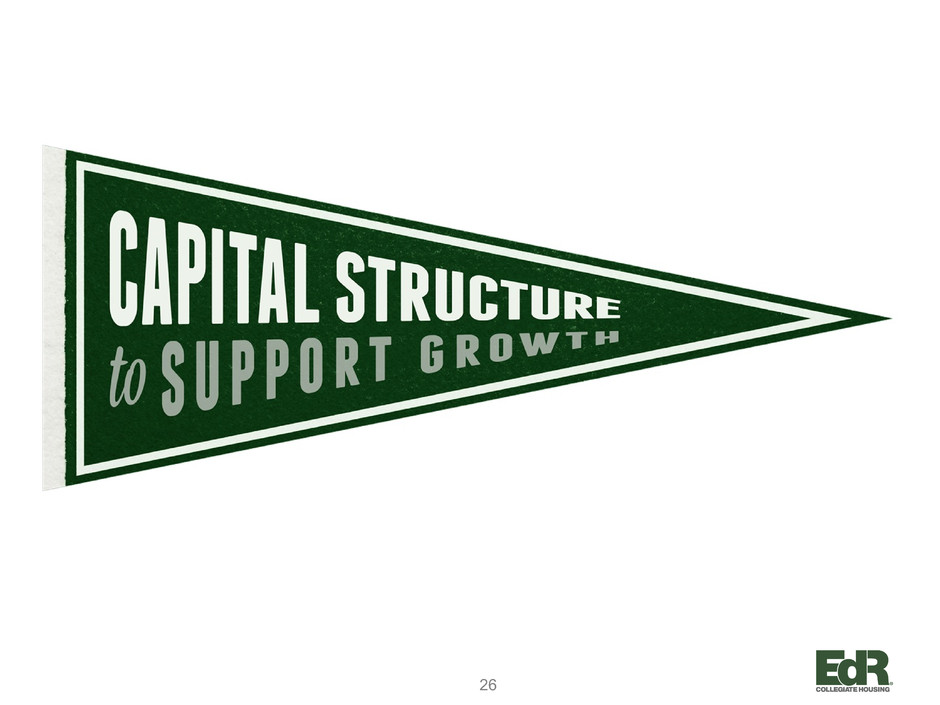
26

27
Approach to Funding Capital Commitments
Capital Structure to Support Growth
• Capital commitments include developments and acquisitions we are contractually
obligated to complete
• Maintain debt to gross asset target range of 25% - 30%
• Capital sources include cash on hand, cash from operations, current debt
facilities, capital recycling and equity issuance depending on market conditions
and economics
• ATM is most efficient source of equity due to low execution cost and ability to do
over time as capital is needed. Forward option on ATM protects against current
dilution.
• Sold $487 million in assets since 2010, representing 70% of assets owned at the
beginning of 2010
• Every incremental development or acquisition commitment requires equity
funding or capital recycling of 70% - 75% to maintain debt to gross asset range
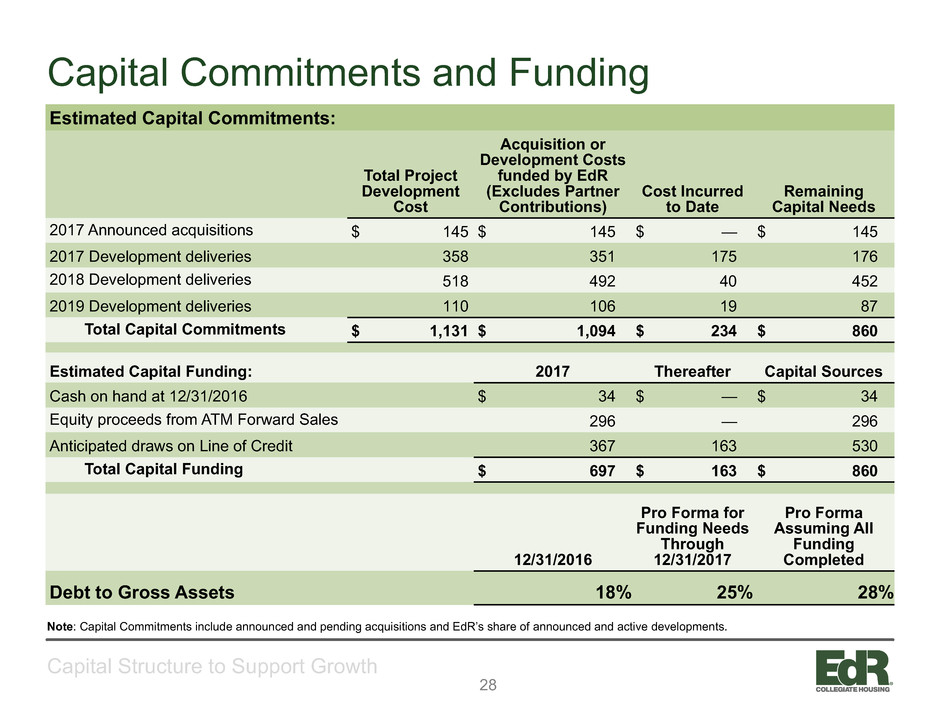
28
Capital Commitments and Funding
Capital Structure to Support Growth
Estimated Capital Commitments:
Total Project
Development
Cost
Acquisition or
Development Costs
funded by EdR
(Excludes Partner
Contributions)
Cost Incurred
to Date
Remaining
Capital Needs
2017 Announced acquisitions $ 145 $ 145 $ — $ 145
2017 Development deliveries 358 351 175 176
2018 Development deliveries 518 492 40 452
2019 Development deliveries 110 106 19 87
Total Capital Commitments $ 1,131 $ 1,094 $ 234 $ 860
Estimated Capital Funding: 2017 Thereafter Capital Sources
Cash on hand at 12/31/2016 $ 34 $ — $ 34
Equity proceeds from ATM Forward Sales 296 — 296
Anticipated draws on Line of Credit 367 163 530
Total Capital Funding $ 697 $ 163 $ 860
12/31/2016
Pro Forma for
Funding Needs
Through
12/31/2017
Pro Forma
Assuming All
Funding
Completed
Debt to Gross Assets 18% 25% 28%
Note: Capital Commitments include announced and pending acquisitions and EdR’s share of announced and active developments.
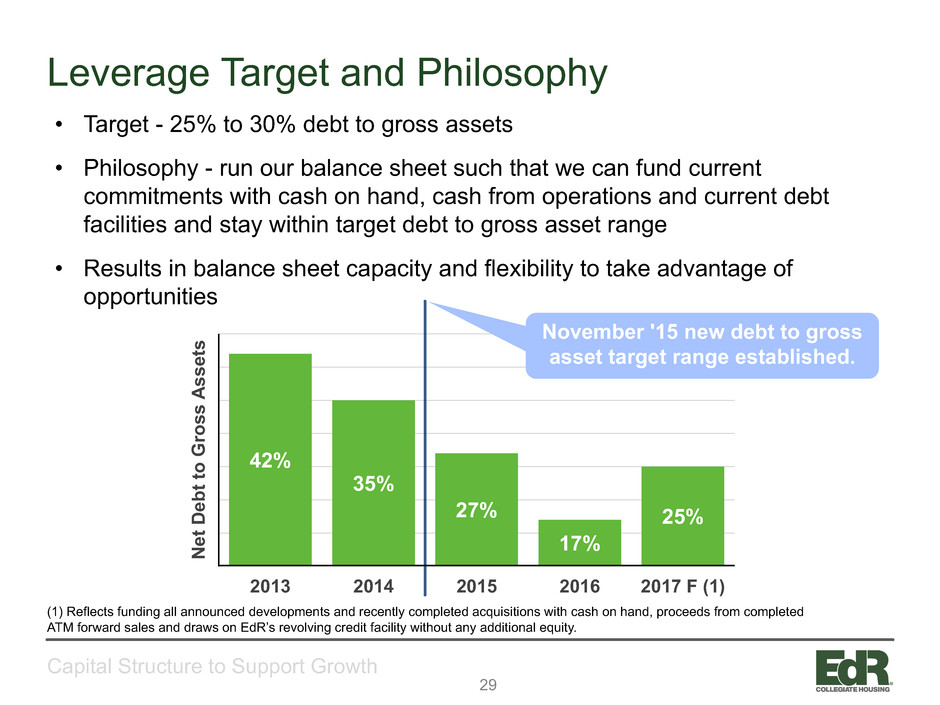
29
Leverage Target and Philosophy
Capital Structure to Support Growth
• Target - 25% to 30% debt to gross assets
• Philosophy - run our balance sheet such that we can fund current
commitments with cash on hand, cash from operations and current debt
facilities and stay within target debt to gross asset range
• Results in balance sheet capacity and flexibility to take advantage of
opportunities
(1) Reflects funding all announced developments and recently completed acquisitions with cash on hand, proceeds from completed
ATM forward sales and draws on EdR’s revolving credit facility without any additional equity.
N
et
D
eb
tt
o
G
ro
ss
As
se
ts
2013 2014 2015 2016 2017 F (1)
42%
35%
27%
17%
25%
November '15 new debt to gross
asset target range established.

30
Debt Metrics December 31, 2016
Capital Structure to Support Growth
Source: Company financial supplements and KeyBanc Corp
Net Debt to Gross
Assets
Ed
R
AC
C
Mu
lti-
Fa
mi
ly
17%
37%
44%
Debt to EBITDA
Ed
R
AC
C
Mu
lti-
Fa
mi
ly
3.7X
5.2X
7.5X
Interest Coverage
Ed
R
AC
C
Mu
lti-
Fa
mi
ly
9.0X
4.5X
5.4X
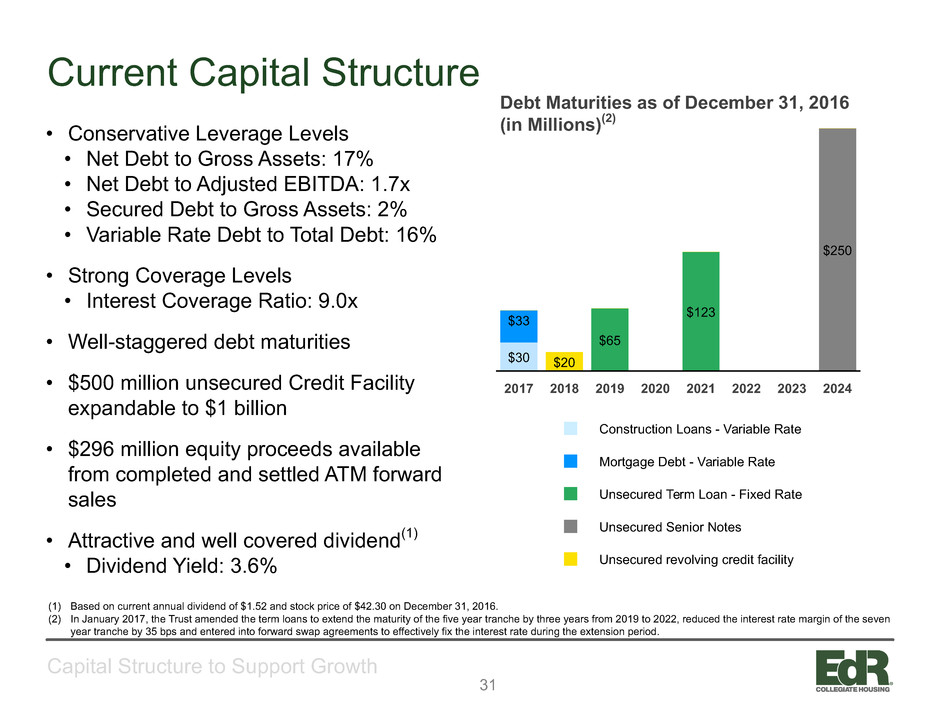
31
Current Capital Structure
Capital Structure to Support Growth
• Conservative Leverage Levels
• Net Debt to Gross Assets: 17%
• Net Debt to Adjusted EBITDA: 1.7x
• Secured Debt to Gross Assets: 2%
• Variable Rate Debt to Total Debt: 16%
• Strong Coverage Levels
• Interest Coverage Ratio: 9.0x
• Well-staggered debt maturities
• $500 million unsecured Credit Facility
expandable to $1 billion
• $296 million equity proceeds available
from completed and settled ATM forward
sales
• Attractive and well covered dividend(1)
• Dividend Yield: 3.6%
(1) Based on current annual dividend of $1.52 and stock price of $42.30 on December 31, 2016.
(2) In January 2017, the Trust amended the term loans to extend the maturity of the five year tranche by three years from 2019 to 2022, reduced the interest rate margin of the seven
year tranche by 35 bps and entered into forward swap agreements to effectively fix the interest rate during the extension period.
Construction Loans - Variable Rate
Mortgage Debt - Variable Rate
Unsecured Term Loan - Fixed Rate
Unsecured Senior Notes
Unsecured revolving credit facility
2017 2018 2019 2020 2021 2022 2023 2024
$30
$33
$65
$123
$250
$20
Debt Maturities as of December 31, 2016
(in Millions)(2)
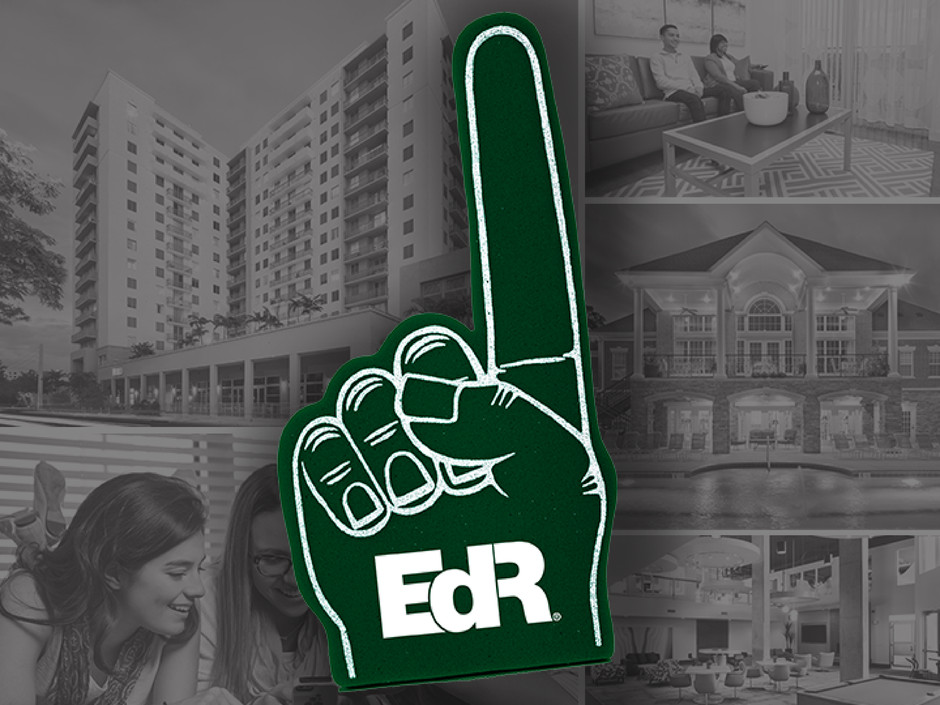
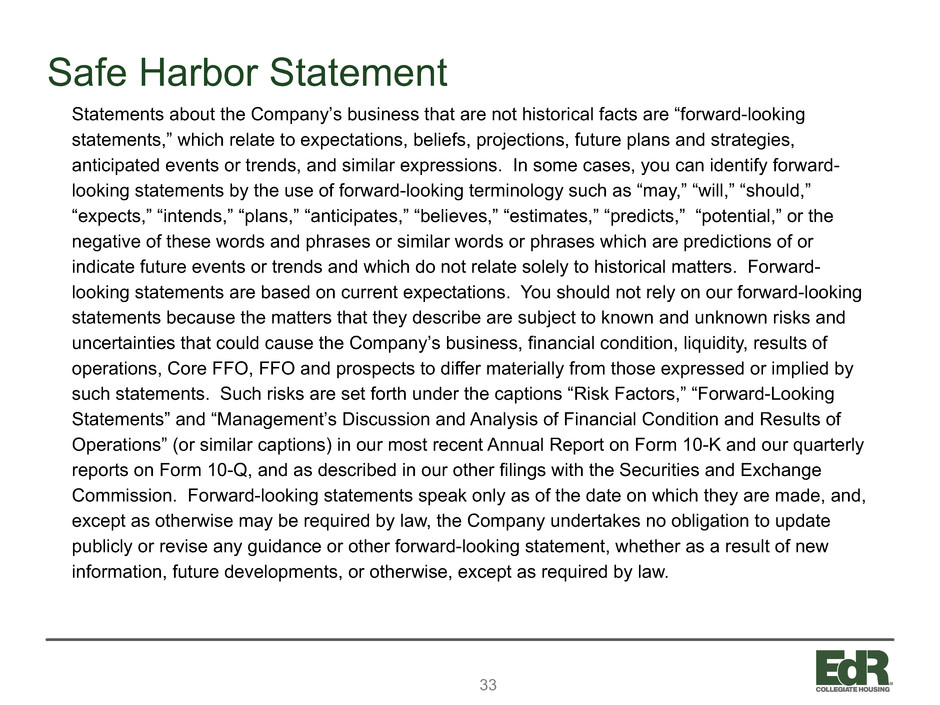
33
Safe Harbor Statement
Statements about the Company’s business that are not historical facts are “forward-looking
statements,” which relate to expectations, beliefs, projections, future plans and strategies,
anticipated events or trends, and similar expressions. In some cases, you can identify forward-
looking statements by the use of forward-looking terminology such as “may,” “will,” “should,”
“expects,” “intends,” “plans,” “anticipates,” “believes,” “estimates,” “predicts,” “potential,” or the
negative of these words and phrases or similar words or phrases which are predictions of or
indicate future events or trends and which do not relate solely to historical matters. Forward-
looking statements are based on current expectations. You should not rely on our forward-looking
statements because the matters that they describe are subject to known and unknown risks and
uncertainties that could cause the Company’s business, financial condition, liquidity, results of
operations, Core FFO, FFO and prospects to differ materially from those expressed or implied by
such statements. Such risks are set forth under the captions “Risk Factors,” “Forward-Looking
Statements” and “Management’s Discussion and Analysis of Financial Condition and Results of
Operations” (or similar captions) in our most recent Annual Report on Form 10-K and our quarterly
reports on Form 10-Q, and as described in our other filings with the Securities and Exchange
Commission. Forward-looking statements speak only as of the date on which they are made, and,
except as otherwise may be required by law, the Company undertakes no obligation to update
publicly or revise any guidance or other forward-looking statement, whether as a result of new
information, future developments, or otherwise, except as required by law.
